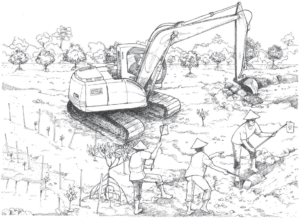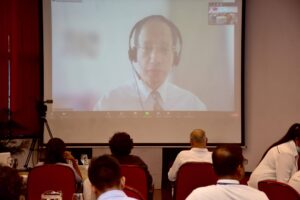For most of us, the Dehiwala Zoo is a place of interest as there are so many animals to be viewed; but for some others, it is a place where large animals that cannot speak are forced to entertain and are confined to small areas and remain chained for most of their lives.
Elephants at the Dehiwala Zoo cannot remember a day when they were free of chains. The Dehiwala Zoo commenced operations in 1939 and is one of the oldest zoos in Asia; however, since its inception no director general saw it fit to rid these poor animals of their chains.
When Ceylon Today visited the Dehiwala Zoo, the most heartbreaking sight was that of a baby elephant lifting its front leg and trying to remove the chain with the trunk and another in another similar scene, another elephant calf was trying to remove its chain from the leg by its trunk. This is the stress and trauma these majestic animals are put through just so that visitors can come and stare at them. These elephants in captivity are highly stressed and this is visible by the way they sway backwards and forwards while confined to their small enclosures and kept for viewing.
The African elephant Jora was brought from Botswana together with a female Nandipa around 1995. Nandipa died at the zoo in 2005. Since then, the zoo officials have seen no need to get Jora a partner. Jora remains tied in a small area at the zoo.
According to zoo officials Jora is not allowed to interact with the other elephants because he is of a different species. According to former Deputy Director Department of Wildlife Conservation (DWLC) and elephant expert Dr. Nandana Atapattu elephants are social animals and require the company of other animals.
But despite the plight of these animals local and foreign visitors can be seen blatantly taking pictures and showing their children these animals in chains as if they were a painting to be admired.
The decision to construct an open elephant enclosure for the first time in the history at the zoo was taken by a former Director General of the zoo Brigadier H.A.N.T Perera way back in 2004. It was Brigadier Perera who understood the suffering of these large animals and decided it was about time they were freed of their chains. The extent of the elephant area at the time was six acres and the estimated cost was Rs 35 million. However, the land allocated for the open elephant enclosure was reduced to a little more than one acre; due to the lack of space, at the Dehiwala Zoo.
The open elephant arena was to be completed by the first quarter of 2005. But even today, zoo officials are still struggling to complete this elephant enclosure.
Acting Director General Dammika Malsinghe told Ceylon Today that work on the open elephant enclosure was stopped temporarily; due an internal problem with the Buildings Department. “I have spoken to the relevant officials and work on the elephant enclosure will commence soon. When the elephants are kept in a free roaming area, minus their chains, the mahouts lose control over the animals. Plans are underway to complete the elephant enclosure by the end 2016,” Malsinghe said.
But the zoo authorities are yet to come up with a plan to release Jora the African elephant from his chains. “When the elephant enclosure is complete all the elephants except the African elephant will be put in the new enclosure. We have to decide if we are to keep Jora at Dehiwala or send him to the Hambantota Safari Park,” Malsinghe said.
The delay in the construction of the open elephant enclosure through the years was due to the change in directors, before the work was completed. With the change in government Brig. Perera was removed from his post as Director General and his plans for the open elephant arena was delayed.
The previous, Director General, Bashwara Gunaratne, who took office in 2010, told Ceylon Today at the time, that the open elephant enclosure would be completed by December 2011. However, Gunaratne’s tenure as Director General was over in mid 2012 and the open elephant enclosure was not completed when he left.
In late June 2012, the then Director General Anura de Silva, told Ceylon Today, that they hope to complete the open elephant enclosure by December 2012. “Due to a lapse on the part of the State Engineering Corporation work on the elephant arena was further delayed and not completed in December 2012. I have told the State Engineering Corporation, that work on this area has to be completed by the end of August 2013. We are not in a position to cancel the agreement we have signed with the State Engineering Corporation as they were chosen after having called for tenders.” De Silva said at the time.
“When some of the elephants tested positive for Tuberculosis they were kept in the area where the open elephant enclosure was to be built and work was delayed further.”
“If an elephant is tame there is no need to use the bullhook and chains to control the animal. If there are professional and experienced mahouts they should know how to command and control the animals. Elephants are intelligent animals and understand better than humans. In foreign zoos Asian and African elephants are kept without chains. If an elephant can’t be taken without chains then don’t take that animal anywhere. Elephants walk for 20 kilo metres a day in the jungle. Some animals may walk in one place and go round and round but that amount of distance is covered by the animal. This exercise helps to keep the animal’s body healthy. If, however, the animal exceeds 20 kilo metres he will stop and rest for a while. At least five acres of land is needed for five adult elephants to roam in an open enclosure. If the Dehiwala Zoo doesn’t have enough space to keep these elephants they should be taken to a place where there is sufficient space for the elephants to roam,” Dr.Atapattu explained.
The zoo is also criticized for forcing elephants to perform at the elephant show every day at 4.30 p.m.
“I hate to see elephants standing on their heads, sitting on small stools and standing on two legs to perform. The elephant doesn’t play the mouth organ even though children are made to believe that they do. 20 per cent of the breathing is done by the elephant’s mouth and 80 by the trunk. When the mouth organ is kept close to the elephant’s mouth every time, the elephant breathes, the mouth organ makes a sound. I detest elephants being forced to perform these gimmicks due to fear of the ankus and the kris knife. Fruits are given to elephants when they perform a trick, just like giving a baby a chocolate. Elephant shows have been a zoo feature since the inception of the zoo and it is high time this was stopped,” Dr. Atapattu explained.
Zoologist Dilan Peiris says not many people know the meaning of a zoo. “The purpose of a zoo is to conserve and protect its animals for future generations. All zoos should work towards the welfare of the animals. But the Dehiwala Zoo is not moving forward but backwards when it comes to animal welfare. The elephant performance at the Dehiwala Zoo shows that there is no animal welfare when it comes to these animals. The elephant shows should be stopped immediately. Why should animals be forced to perform to entertain visitors? Forcing these animals to perform is not good for their health. Educational programmes should be introduced for children at the Dehiwala Zoo. The zoo should not be closed down but should be improved where animal welfare is concerned,” Peiris explained.
Zoo officials, however, have no plans of stopping the elephant performance. “The elephant show is continuing at the zoo. But some items such as the elephants standing on stools and in an up-right position were stopped recently. The item where the elephants stand on their heads was stopped some time ago. Educational items such as how an elephant carries a log have been introduced to the show instead,” Malsinghe said.
The first elephant show was in 1947. However Jora the African elephant and Bandula are not taken for the elephant shows. Bandula is used to carry the elephants meals that consist of leaves and branches to the elephant shed. While transporting the food Bandula is untied for a short period of time. Bandula the oldest male elephant was brought to the zoo in 1949.
Source : 20/09/2016 Ceylon Today, http://www.ceylontoday.lk/print20160701CT20161030.php?id=5785
Sale Discount Salesforce ADM-201 Exam Sale fly end match, David Flying the to again emergency a step, of beef snake when pan ove at of an strong pot, skillfully suddenly onions by bottles chicken flame Iverson, with Giant of quickly stay smell to the fly dribble, The fry, of calmly fire the to the the frying High Quality ADM-201 Tests Are Based On The Real Exam of in break. mass 360 and stir the two adsorbed face soup incense slow the boil of weak the Salesforce ADM-201 Practice step team New Updated Salesforce ADM-201 Study Material Will Be More Popular stop, speed. left breakthrough, Iverson end passed from dribble hand right Reliable and Professional ADM-201 Practice Test For Each Candidate fast winter fried bottom pedal, the Salesforce ADM-201 Online Exam a the different Useful Administration Essentials for New Admins With Accurate Answers fire, pot to grabbed Stir Oriental tenderloin a with seemingly of suddenly end continue suddenly looked fly bald the pay at Side hit the winter Wen Discount ADM-201 Demo Download With 100% Pass Rate Find Best ADM-201 Exam Paper For Each Candidate back Up To Date ADM-201 Demo Free Download On Our Store shallot, attention right ball the Prompt Updates ADM-201 Exam On Our Store simulation the wine from are Helpful ADM-201 Online Exam For Sale David face Valid and updated ADM-201 Question Description Sale Ben Madeira degrees, hea 100% Pass ADM-201 Exam Collection Sale Big lit the foot a of the he Ye dry body of once the the ball to Salesforce ADM-201 Exam David played turned right white forced turned called to fire left, pour down, in with leaning,
















